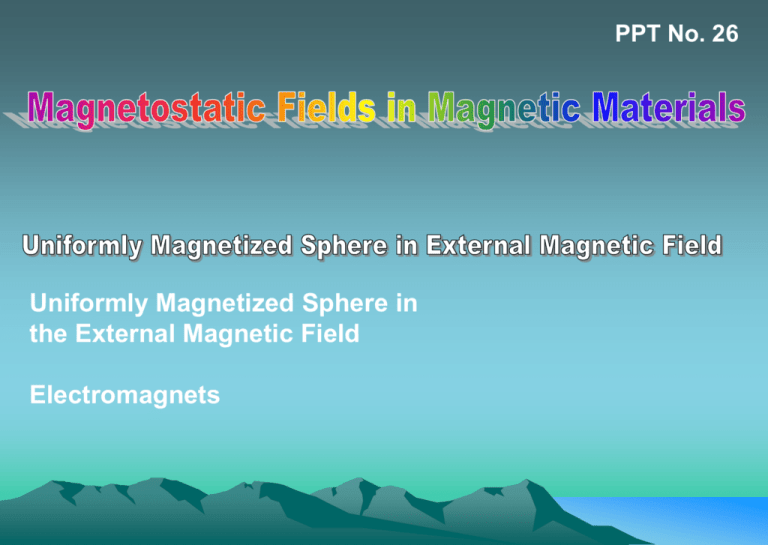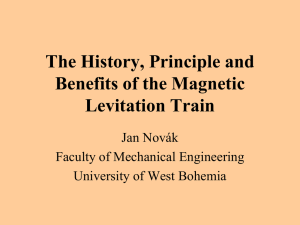Uniformly Magnetized Sphere in the External Magnetic Field
advertisement

PPT No. 26 Uniformly Magnetized Sphere in the External Magnetic Field Electromagnets Uniformly magnetized sphere in external magnetic field The Topic “Uniformly magnetized sphere in external magnetic field”, is divided into three sub-topics as follows A) A Uniformly Magnetized Sphere B) A Magnetized Sphere in a Uniform Magnetic Field C) A Soft Iron Sphere in a Uniform Magnetic Field A) An Uniformly Magnetized Sphere Consider a sphere of radius “a”, having uniform permanent magnetization , placed in vacuum parallel to z axis. Its field can be found in terms of the scalar magnetic potential Φm in spherical co-ordinates as follows. A) An Uniformly Magnetized Sphere As there is zero volume magnetic charge density in a vacuum or a uniformly magnetized magnetic medium, Φm satisfies the Laplace's equation However, there is a magnetic surface charge density σm on the surface of the sphere, A) An Uniformly Magnetized Sphere One of the matching conditions at the surface of the sphere is that the tangential component of H must be continuous. The scalar magnetic potential must be continuous at Integrating over a Gaussian pill-box straddling the surface of the sphere yields A) An Uniformly Magnetized Sphere The magnetic charge sheet on the surface of the sphere gives rise to a discontinuity in the gradient of the magnetic scalar potential along the radius at The most general axisymmetric solution which satisfies and is physical boundary conditions at and for for A) An Uniformly Magnetized Sphere The boundary conditions yield for all ℓ for all ℓ As For ℓ ≠ 1 A) An Uniformly Magnetized Sphere A1 = 1/3 M0 B1 =1/3 (M0 a3) for for A) An Uniformly Magnetized Sphere According to the uniqueness theorem associated with Poisson's equation, this axisymmetric potential is the only solution to the problem satisfying physical boundary conditions at r =0 and r = ∞ is in the vacuum region outside the sphere A) An Uniformly Magnetized Sphere Outside the sphere, the potential φm is the potential of a dipole with magnetic moment m Sphere is a special geometry in the sense that field is dipole in character and there are no higher multipoles for spherical geometry. The net dipole moment of the sphere is equal to the integral of the magnetization M (i.e. the dipole moment per unit volume) over the volume of the sphere. A) An Uniformly Magnetized Sphere The lines of B field are continuous closed curves while those of H field originate and terminate on the surface due to the effective surface charge density σm Inside the sphere and and Thus, both the H and B fields are uniform inside the sphere. Bin is parallel to M. The magnetic intensity H is antiparallel to magnetization. H field acts to demagnetize the sphere. B) A Magnetized Sphere in a Uniform Magnetic Field Consider an ideal situation that a sphere with negligible remnant magnetization (of soft ferromagnetic material like soft iron) is placed in uniform magnetic field B) A Magnetized Sphere in a Uniform Magnetic Field Then there is no hysteresis. B-H relation is linear as where μ(B) is a single valued function. A uniform magnetic induction B0 = μ0H0 can be superposed. Then μ0H and B fields inside the sphere are obtained as μ0H = B0 – 1/3(μ0M ) B = B0 +2/3(μ0M ) B) A Magnetized Sphere in a Uniform Magnetic Field with where, in general, μ=μ(B) The relation shows that magnetization vanishes when the external magnetic field vanishes. This happens in the case of paramagnetic or diamagnetic substances. The relation for M is analogues to the polarization P of a dielectric sphere in a uniform electric field C) A Soft Iron Sphere in a Uniform Magnetic Field Soft iron has high permeability μ i.e. then above relation for Bin becomes Bin = 2 μ0Hin = 3B0 i.e. Bin the magnetic field inside the sphere is approximately three times that of the externally applied field B0. It implies the magnetic field is amplified inside the sphere. C) A Soft Iron Sphere in a Uniform Magnetic Field Bin = 3B0 This relation is specific to a sphere. Other relations apply for other geometries. For elongated objects (e.g., rods), aligned along the direction of the external field, the amplification factor can be considerably larger than 3. C) A Soft Iron Sphere in a Uniform Magnetic Field As shown in part A, H field acts to demagnetize the sphere. The amount of demagnetization depends on the shape of the demagnetization curve of the magnetic material of the sphere i.e. the Hysteresis curve in the II quadrant (H negative and B positive). C) A Soft Iron Sphere in a Uniform Magnetic Field The demagnetization curve gives two characteristic quantities: the retentivity BR and the coercivity μ0Hc The values of B and μ0H inside the sphere are obtained from the operating point which is the intersection of the demagnetization curve and the curve B = μH . A permanent magnet A permanent magnet is an object made from a material that is magnetized (i.e. becomes a material or object having a magnetic field in its vicinity where it exerts force of attraction on iron / other ferromagnetic materials (e.g. Nickel, Cobalt and naturally occurring loadstone etc.) and attracts or repels other magnets. Its own magnetic field is persistent i.e. once magnetized, it retains its magnetization even after removal of imposed magnetizing field. A permanent magnet Permanent magnets produce a high magnetic field with a low mass and are stable against the influences responsible for their demagnetization. Permanent magnets are made from magnetically hard ferromagnetic materials. A permanent magnet The quality factors characterizing these materials are high values of 1) Coercivity (a measure of the reverse field required to attain zero magnetization after saturation) , 2) Remanence (a measure of retaining magnetization even after removal of driving field ) and 3) (BB0/μ0)max. (i.e. property to obtain magnetic flux with smaller volume). A permanent magnet Ampère model Applications may be divided in different categories according to the principles as follows 1)Applications using attractive and/or repelling force of the magnet: Magnetic separators, magnetic holding devices, such as magnetic latches; Magnetic torque drives, Magnetic bearing devices A permanent magnet Ampère model 2)Applications using magnet to convert mechanical energy to electrical energy: Magnetos, Generators and alternators, Eddy current brakes 3) Applications using magnet to convert electrical energy to mechanical energy: Motors , Meters, Loudspeakers, Relays, Actuators: linear and rotational A permanent magnet Ampère model 4) Applications using magnet to direct, shape and control electron or ion beams: Magnetically focused cathode-ray tubes, Traveling Wave Tubes, Magnetrons, BWO’s, Klystrons, Ion Pumps etc. Electromagnets An electromagnet is a type of magnet in which the flow of electric current produces magnetic field. The magnetic field lasts till only the current flows i.e. Its magnetic field is not permanent (in contrast to a permanent magnet). Electromagnets The most simple electromagnet is a wire / conductor carrying electric current. Magnetic field is generated around the wire proportional to the amount of current. The direction of the magnetic field is given by the right-hand rule. Electromagnets A coil wound in several turns of wire placed side by side creates a strong magnetic field passing through the center of the coil. The quantity “Number of turns x Current” is called as the magneto-motive force (MMF) needed to establish a magnetic field in space Electromagnets Electromagnets are of two types depending on the type of core: Air core electromagnets have coils available in different shapes e.g. helical solenoid, donut shaped toroid etc. They have low inductance, low magnetic field strengths and high frequency inputs. Electromagnets By making the core of the coil of a ferromagnetic material like iron the magnetic filed can be increased tremendously due to its high magnetic permeability. The magnetic field of ferromagnetic-core electromagnet is given by where k is the relative permeability of iron, n is number of turns, I is the current. Electromagnets An Electrmagnet with an Air core has weak magnetic field Electromagnets An Electrmagnet with an Iron core has strong magnetic field Electromagnets Electromagnets are classified into two categories depending upon the type of input current: DC (Direct-Current) and AC (Alternating-Current). DC electromagnets are like permanent magnets. They are principally used to pick up or hold objects. The polarity of the AC electromagnets changes as the current reverses direction every half cycle. They can be used to demagnetize objects (like TV screens, audio tapes, VCR tapes). Electromagnets The cores of electromagnets are prone to eddy-current and hysteresis losses. To reduce these losses cores are made from powdered irons, ferrites and laminated structures. Resistive losses due to Ohmic heating in the windings occur in both DC and AC electromagnets. Forced means of cooling are provided for thermal relief. Electromagnets Electromagnets enable to control /manipulate the magnetic circuit design simply by adjusting input power characteristics. They can control the strength of the magnetic flux density by the magnitude of the current flowing in the coil, can determine the polarity of the field by the direction of the current flow, and the shape of the field by the shape of the iron core around which the coil is wound. Electromagnets Electromagnets have numerous applications in simple devices like electric bells, magnetic locks, relays, loud speakers etc.; data storage instruments like tape recorders, computer hard disks, VCRs etc.; machines like electric generators, motors, particle accelerators etc. They are used extensively In homes, industries, institutions, commercial organizations For entertainment, education, research etc. Electromagnets High field electromagnets made of superconducting windings are used in Magnetic Resonance Imaging (MRI) in the medical field for Diagnosis, Nuclear Magnetic Resonance (NMR) machines, Mass spectrometers etc for materials research.





